Whenever a person wants to lose weight the first thing that usually comes to their mind is that they must do hours of boring cardio. They have the mentality that they must go in at least 5x/week for at least 45 minutes to lose weight quickly.
This is quite evident if you walk into the gym. You will see all the overweight people on the cardio equipment and all of the lean people lifting weights. But wait, maybe it is possible that the leaner people are lifting weights because it works better for fat loss? Yes, this is very possible and in fact the truth. Long slow distance cardio, the traditional way to lose fat is actually highly ineffective for weight loss. The proper weight training and interval training program is far superior for not only losing weight but a bunch of other health benefits as well.
Now think about this: who is leaner, a marathon runner or a 100 meter sprinter? If you don’t know the answer it is the 100 meter sprinter. Even though the marathon runner runs for way longer time the fast sprints are much more effective for fat loss. You will even notice the marathon runner carrying quite a bit of fat. They will also be much less muscular as long slow distance cardio eats away at muscle tissue thus lowering your metabolism.
I have trained a lot of marathon runners. When they first come to see me most of them are not only unusually weak but they also carry a higher percentage of body fat than you would expect for someone who does that high volume of cardio. Once we cut back on the cardio and add in some weight training and interval sprints they not only become leaner and stronger, but injuries go away as well.
So why is traditional cardio so bad for weight loss?
- Excessive cardio is shown to increase cortisol levels. Cortisol is a stress hormone and causes you to hold body fat, especially around the stomach. This is why people who have high stress jobs hold more belly fat. Also if cortisol is a stress hormone why do we want to do activities that elevate it? People were not meant to do long duration cardio, they were meant for short bursts of hard work.
- Cardio eats away at muscle tissue. Since muscle tissue is active it raises metabolism. So cardio actually decreases metabolism by making you have less muscle tissue. Definitely something we do not want if we are trying to lose weight.
- Cardio does not increase Growth Hormone(GH). GH is a very potent fat loss hormone that your body produces naturally. It is also important for gaining muscle mass and is seen as anti-aging as well. This is why professional athletes get caught using the synthetic version. After the age of 30 your body experiences a 1% decline in GH production/year, or 10%/decade. This is one of the reasons why it gets harder to lose weight as we get older. With the proper weight training and interval program we can increase GH naturally.
- Cardio does not increase EPOC (Excess Post Exercise Oxygen Consumption). An elevated EPOC means that metabolism is elevated to a significant degree after exercise is stopped. This is what is referred to as the “after burn.” EPOC is way more dependent on intensity rather than duration which means it is more affected by hard you work and not how long.
- Cardio does not increase a lot of important proteins and enzymes that help the body use fat as fuel.
- Cardio produces a lot of free radicals. While this might not mean much for fat loss it does accelerate aging. This is why people who do excessive cardio look many year older than they actually are.
So how can we manipulate your training program to take advantage of the points that I went over? Interval and resistance training. Interval and resistance training share these fat loss benefits that are not seen by traditional cardio:
- Increase in EPOC
- Increase in GH
- Increase in proteins and enzymes that are associated with burning fats as fuel
- Does not increase cortisol
To drive my point home let’s look at a recent study in the Journal of Medicine and Science in Sports and Exercise. The study took place over 6 weeks and had 2 groups. The first group ran 30 second sprints followed by 4 minutes recovery repeated 4 times then increased to 6 times midway through the study. The other group was the low intensity endurance group which ran at 65% of heart rate max and ran from 30 minutes and increased by 15 minutes every two weeks, to reach 1 hour training sessions.
Let’s have a look at the results after 6 weeks of training:
- The interval group lost and impressive average of 12.4% body fat or 2-3kg.
- The endurance group(traditional cardio) lost and unimpressive .5kg
Now think about this. In this time the interval group actually ran for a total of .75 hours as compared to the endurance group who totalled 13.5 hours. This means they lost way more fat and trained only 1/18 of the time! Would you want to jog for 13.5 hours and only lose a pound of fat? I know I wouldn’t. This is why a lot of people give up on their weight loss programs when they go this route. It’s too boring and too slow of results. It must be noted that the interval training must be performed maximally to see results. The interval programs I give my clients range from 15-35 minutes 2-3x/week. You will see significant weight loss on a program like this, especially if your diet is in check. I would like to caution that beginners should not follow an interval program at the beginning as they should be gradually worked up to.


